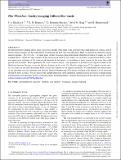Files in this item
The Thresher : lucky imaging without the waste
Item metadata
| dc.contributor.author | Hitchcock, J A | |
| dc.contributor.author | Bramich, D M | |
| dc.contributor.author | Foreman-Mackey, D | |
| dc.contributor.author | Hogg, David W | |
| dc.contributor.author | Hundertmark, M | |
| dc.date.accessioned | 2022-04-01T16:30:14Z | |
| dc.date.available | 2022-04-01T16:30:14Z | |
| dc.date.issued | 2022-04 | |
| dc.identifier | 278684559 | |
| dc.identifier | de855955-9378-4c24-aeeb-7545af7fc931 | |
| dc.identifier | 85126784966 | |
| dc.identifier | 000765485300007 | |
| dc.identifier.citation | Hitchcock , J A , Bramich , D M , Foreman-Mackey , D , Hogg , D W & Hundertmark , M 2022 , ' The Thresher : lucky imaging without the waste ' , Monthly Notices of the Royal Astronomical Society , vol. 511 , no. 4 , pp. 5372-5384 . https://doi.org/10.1093/mnras/stac427 | en |
| dc.identifier.issn | 0035-8711 | |
| dc.identifier.other | Bibtex: 10.1093/mnras/stac427 | |
| dc.identifier.uri | https://hdl.handle.net/10023/25134 | |
| dc.description | JAH acknowledges funding from the Science and Technology Facilities Council of the United Kingdom. | en |
| dc.description.abstract | In traditional lucky imaging (TLI), many consecutive images of the same scene are taken with a high frame-rate camera, and all but the sharpest images are discarded before constructing the final shift-and-add image. Here, we present an alternative image analysis pipeline – The Thresher – for these kinds of data, based on online multi-frame blind deconvolution. It makes use of all available data to obtain the best estimate of the astronomical scene in the context of reasonable computational limits; it does not require prior estimates of the point-spread functions in the images, or knowledge of point sources in the scene that could provide such estimates. Most importantly, the scene it aims to return is the optimum of a justified scalar objective based on the likelihood function. Because it uses the full set of images in the stack, The Thresher outperforms TLI in signal-to-noise ratio; as it accounts for the individual-frame PSFs, it does this without loss of angular resolution. We demonstrate the effectiveness of our algorithm on both simulated data and real Electron-Multiplying CCD images obtained at the Danish 1.54-m telescope (hosted by ESO, La Silla). We also explore the current limitations of the algorithm, and find that for the choice of image model presented here, non-linearities in flux are introduced into the returned scene. Ongoing development of the software can be viewed at https://github.com/jah1994/TheThresher. | |
| dc.format.extent | 13 | |
| dc.format.extent | 2105051 | |
| dc.language.iso | eng | |
| dc.relation.ispartof | Monthly Notices of the Royal Astronomical Society | en |
| dc.subject | Instrumentation: detectors | en |
| dc.subject | Methods: data analysis | en |
| dc.subject | Techniques: image processing | en |
| dc.subject | QB Astronomy | en |
| dc.subject | QC Physics | en |
| dc.subject | DAS | en |
| dc.subject | NIS | en |
| dc.subject.lcc | QB | en |
| dc.subject.lcc | QC | en |
| dc.title | The Thresher : lucky imaging without the waste | en |
| dc.type | Journal article | en |
| dc.contributor.institution | University of St Andrews. School of Physics and Astronomy | en |
| dc.identifier.doi | 10.1093/mnras/stac427 | |
| dc.description.status | Peer reviewed | en |
This item appears in the following Collection(s)
Items in the St Andrews Research Repository are protected by copyright, with all rights reserved, unless otherwise indicated.

